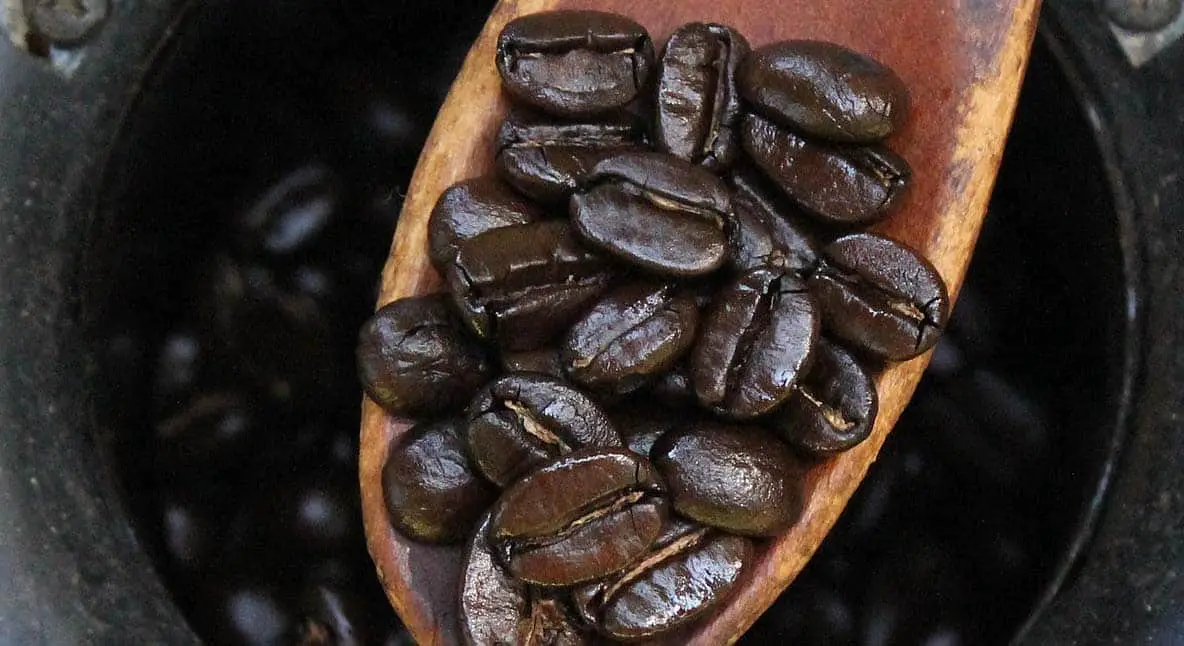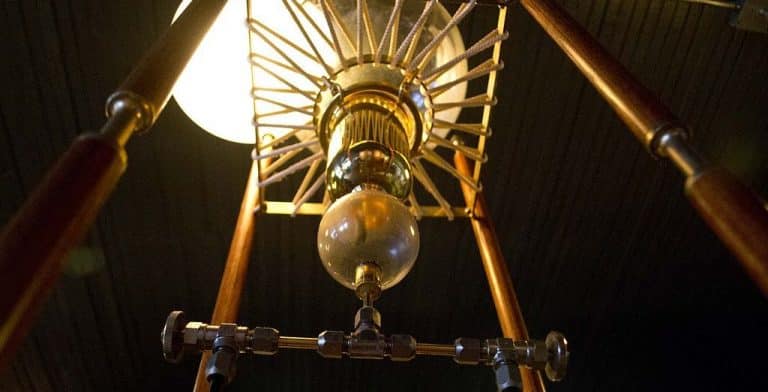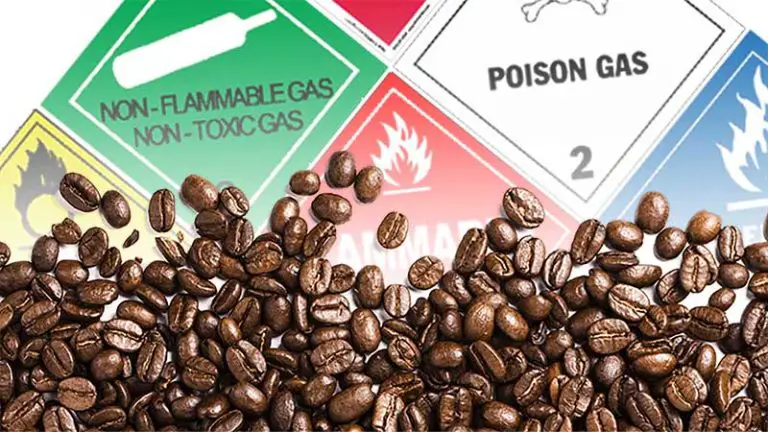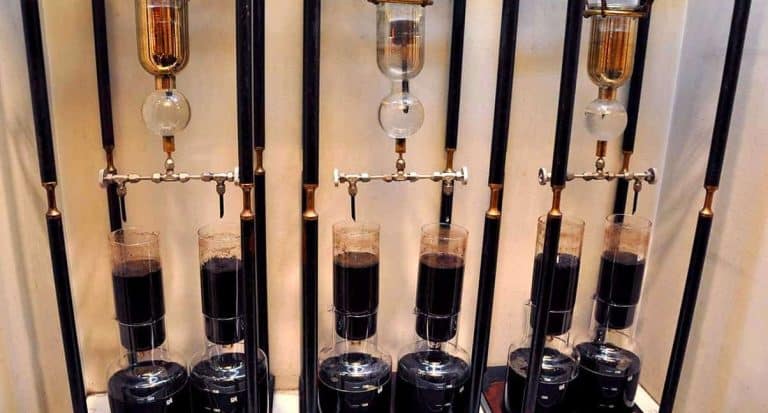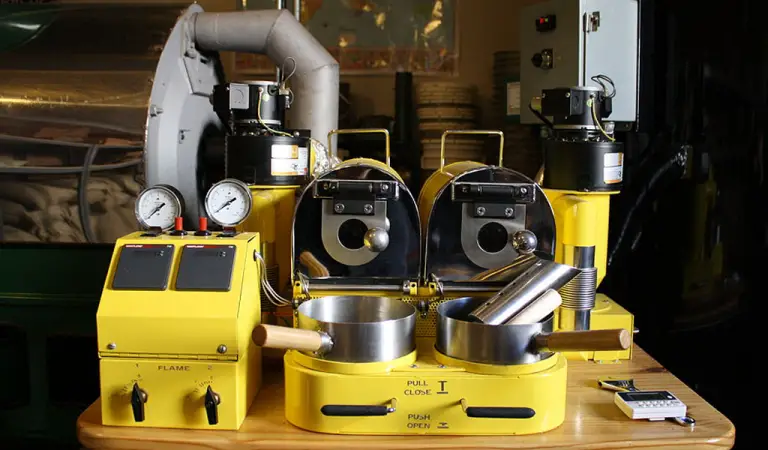Which are the Best Coffee Roasters Under $300?
Once again we experience the price floor in good coffee roasting machines where prosumer units usually begin around $1000 or higher. My research into coffee roasters under $300 found only two really viable solutions in this price range and both have some compromises.
One is the Kaldi Manual Home Coffee Roaster, is a stripped down, manually cranked drum roaster. The other by Korean manufacturer the Imex CR-100, is a completely set-and-forget air roaster which allows for minimal roasting. It’s small and designed to fit seamlessly on your kitchen counter. The features and advantages of each is discussed below and depends on your preferences. I had a hard time deciding. At this price point I found a very limited range of serious roasters that provide can reliable results and are solidly built. After looking at a range of roasters I found these to be the only viable choices.
Skip to the Imex review | Skip to the Kaldi review
Our Choice
The Kaldi Manual Home Coffee Roaster
I liked the simplicity and durability of the Kaldi because it produces a broad range of roasts ranging for light or dark and allows a beginner roaster to develop the skills required to really progress in roasting their own coffee.
There’s nothing else available at this price range to compete in my opinion and you have to spend hundreds more to get more. Even then this roaster in the hands of a skilled home roaster produces coffee of equal quality.
Highly recommended – 4.5/5
1. IMEX CR-100
Roaster Type: Hot air roaster | Capacity: 130-170g | Smoke suppression: Hot air re-circulation | Place of Manufacture: Korea (requires 220V supply)
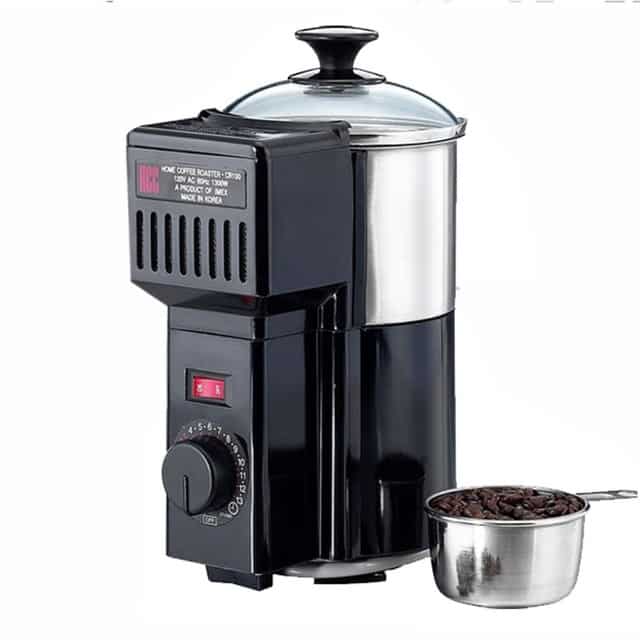
The Imex CR-100 is a simple reliable automated hot air coffee roaster which produces a good quality roast. It is simple to operate and is perfect for a coffee enthusiast who is interested in spending time enjoying good coffee. It has little in the way of adjustment or settings other than roast timing. Also it requires 220V power.
It doesn’t have the versatility of a drum roaster like the Kaldi (reviewed below) but is set and forget and comes complete whereas the Kaldi is much more hands-on (literally), is manually operated and requires you supply a gas heating source which adds to the final price.
What I liked:
- Set and forget – beginner friendly
- Roasts beans evenly
- Re-circulation reduces smoke output
- Good quality roast with most flavors retained
- Stainless roast chamber
What I didn’t like:
- Small roast capacity
- Dark roasts or overloading can create heavy smoke
- Fan can be a bit noisy
- Difficult to hear first/second crack
- Not possible to develop a roast profile
- No 110v power option, need 220V supply or converter (see option here)
What I liked most about the Imex is the no-nonsense design and like many Korean manufactured products is refreshingly uncomplicated and well built. Imex Corporation is a manufacturer of professional coffee roasters so you know they paid attention to this roaster.
It’s sold as an automatic set and forget roaster but does require you to start the cooling cycle. I found it really intuitive to use and the roast quality was really good.
Build and design:
The Imex is a simple design with fan driven hot air directed at vents in the sides of a stainless steel roasting chamber. The top is closed with a glass lid. The fan forces air through a heating element under the roast chamber which circulates the beans.
The hot air exhaust out the top of the chamber, through a chaff collector and most of it is recirculated back down through a safety mesh to the fan again. This keeps the chaff out of the fan mechanism. It’s not a completely sealed system as some of the air/fumes do exit out through vents in the side of the unit. This diagram shows it.
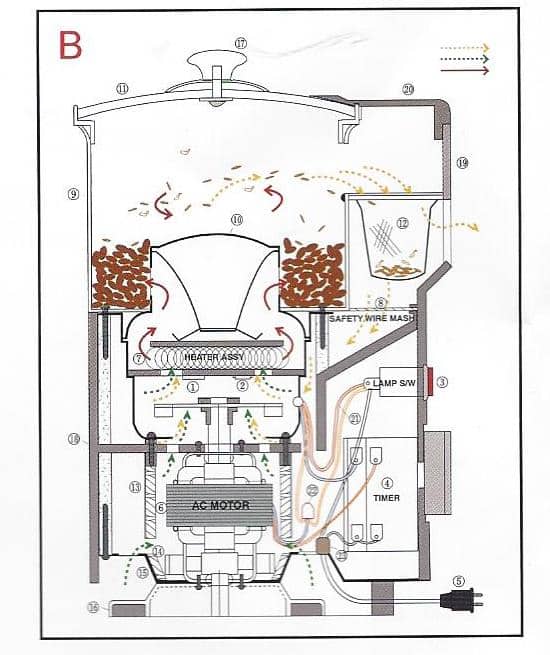
All in all it’s a simple and efficient design which produces an even roast. The design may look a bit dated but it’s straightforward and works well. Cleaning is as simple of lifting out the chaff basket clearing it and wiping out the roast chamber.
The Achilles Heel?
The unit should be cooled down between uses or after roasting by letting the cooling fan running for a few extra minutes. This will help with the life of the heating element. Also, you should not exceed the manufacturer’s suggested maximum green bean capacity for dark or light roasts.
This could slow the bean circulation and restrict air flow and result in the heating element overheating. Some people have complained of the heating element not working after a while and I suspect it is due to this.
Overloading is tempting on this unit because it has a small capacity but stay within recommended specs and it should be alright.
Control:
Controls are simple with not many variables other than time in the roasting and the cooling cycles. There’s an illuminated power switch situated on the fron above the timer dial which switches between roasting and cooling.
Simply switch on power, turn the well marked dial to select the roasting time ( marked in white). When roast is finished, set cooling time on same dial (marked in blue).
Roasting:
It’s a straightforward process to roast with the Imex.
- Place about 120-150g of green coffee beans in th roast chamber#
- Turn the rotary switch and select your roasting time (6 to 13 mins)
- When roasting finishes, set cooling timer (3-5 min)
- Remove beans (cool further if finished otherwise roast again)
I found that dark roasts produce quite a bit of smoke with this unit. The re-circulation system works well on reducing smoke but can be overpowered with dark roasts.
The fan can be a bit loud too and together with the noise of the re-circulation beans hitting the metal roast chamber, it’s difficult to hear the cracks, especially the 2nd crack.
The clear glass roasting chamber lid does help though and you can see the color of the beans quite well while roasting. It’s quite an easy roaster to use. And is simply laid out. For those technical roasters among us, here’s a diagram of the internals showing how the hot air is mostly recirculated.
Maintenance and cleaning is important on this unit as in all hot air roasters. You should make sure you clean out the chaff container after each roast and keep the cooling fan running for 20 minutes after roasting. This ensures heat does not build up in the unit and will increase the life of the electrical heating element.
It’s quite a compact unit being about 12 in high. A slight increase in the design size would have greatly improved hot air flow and cooling and possibly lowered fan noise and air friction. I ask myself if the compact size repeated heat/cool cycles will ultimately affect reliability.
The Verdict:
I’m in two minds about this unit actually. It’s a mid priced home roaster and in made mainly of plastic but with careful maintenance can last for a long time. It’s not overly complicated and quite logically put together. It’s small size could be it’s Achilles heel.
This is unfortunately the compromise with most hot air counter top appliances which sometimes sacrifice reliability and long term reliability for looks and compact size.
That being said, I think this is a real option at this price range given that it is almost automatic. The other option I review is the Kaldi Home coffee roaster which is very robust and simple but is completely manual and is sold without a burner.
If you want set and forget simplicity and don’t mind maintaining the machine, The Imex is a good option. If you’re looking for the ability to control how you roast and adjust the roast profile, read on below about the Kaldi unit.
Specifications:
Height: 30cm (12in)
Width: 15cm ( 6in)
Depth: 22cm (9.5in)
Weight: 2.2Kg (4.8 lb)
Power Supply: 220V, (requires converter 220V outlet in US)
Watts: 1300
Warranty: unknown
Check current prices and reviews on Amazon.
2. KALDI Manual Home Coffee Roaster
Roaster Type: Drum Roaster, Capacity: 200g (7oz.) Smoke suppression: None, Heat: Gas Burner(not included), Drive: Manual-crank handle
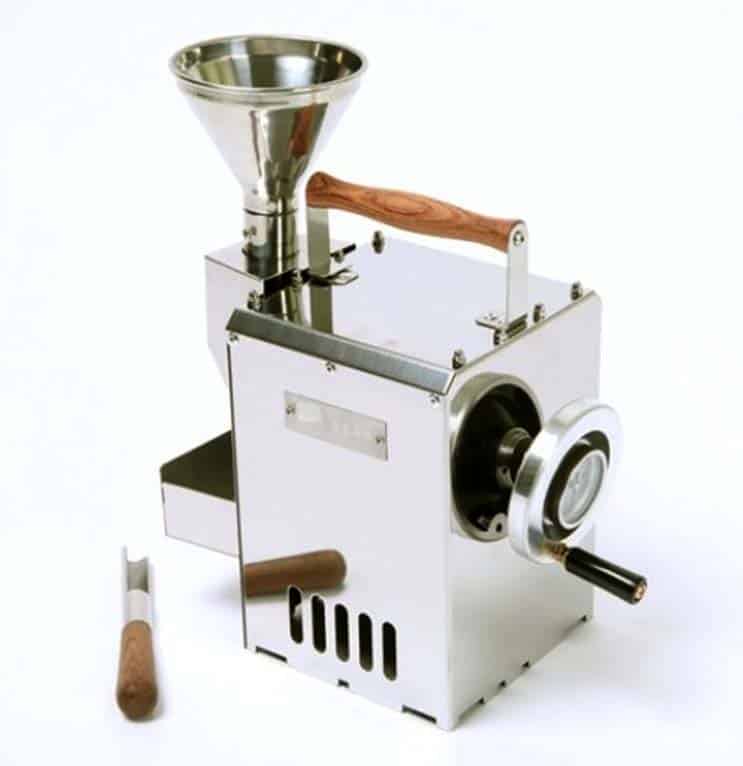
The KALDI Manual Home Coffee Roaster seems to be hidden in open sight. It is a well built versatile drum roaster and is similar in configuration to their much more expensive motor driven units. The downside is that this unit doesn’t have a motor to drive the the drum and relies on a manual crank. It also requires an external heat source like a gas stove or ring which is not included in the purchase price. The upside is that it is significantly cheaper than their motorised units which are built to exactly the same specs and design.
All this aside, I really liked using this roaster because it allows you to endlessly fine tune your roast and develop your perfect roast profile. I’m a hands-on roaster so I like the ability to vary the drum speed, the heat source and the timing intuitively. This video gives an idea about operation.
What I liked:
- Professional build
- versatile
- small size
- simplicity of design/few moving parts
- easy to maintain
- can develop a roast profile
- drum roaster
What I didn’t:
- Manual crank
- have to tilt machine to empty
- no burner supplied
Build and design:
Compared to Others
This roaster is built exactly the same as the higher price Kaldi roasters that sell for hundreds more. The price is lower because it is the “chopped” or stripped down version with the manual crank. It’s built really well in a military sort of way with bent stainless plates bolted and riveted together in a no pretense way unlike some of the roasting “appliances” available which look like toaster ovens or oversized plastic blenders. The look is industrial and quite fitting for a no-nonsense roaster like this. I really like the aesthetic.
It’s a really simple affair with stainless case enclosed on 5 sides, open on the bottom. The roasting drum is angled up slightly towards the front and is rotated with a crank handle on the back. It wouldn’t look out of place in a ship’s engine room, especially with the exposed acorn nuts on the top.
There is space to insert a dial thermometer in the center of the crank. It’s an optional extra and seems to be a standard thermometer. The crank is quite simple to turn evenly and only takes a couple of minutes to get the hang of it.
Do You Really Need a Motor?
I thought the lack of a motor would be a deal killer but truthfully, I wasn’t bothered to crank the handle to roast. I suppose if you roast a lot it may become an issue. There is a more expensive version which comes with the engine and all the accessories which is a really good deal. It’s only about $150 more than this roaster and is worth considering if your budget can stretch a bit.
An interesting addition is a copper sleeve for the roasting drum. This is slipped over the outside of the drum, dissipates the heat and prevents the flames from coming into direct contact with the beans. This is a great addition but does elongate the roasting and heating cycles a bit. It’s great that it’s removable so you can do an A/B test.
I found I like the roast without it. Maybe it’s because the beans roast quicker and don’t bake at all. It’s personal preference and you may find you like it for some roast/bean combinations and not for others.
I found that the chaff tray is a must if you remove the bean chute from the front while roasting. It’s a small roaster and the chaff will be thrown from the font on the first crack. You can leave the chute in place but you won’t be able to sample the beans during roasting and will be almost 100% seat-of-the-pants.
I see no problem with this once you have dialed in your preferred roast profiles. The Kaldi thermometer is analog and quite slow to react and not really suitable for the most discerning roast profile pilots out there. A thermocouple thermometer or a infrared thermometer gun is a better choice and can be bought quite reasonably. Here’s a popular option on Amazon for well under $30.
Just remember that this unit comes without the thermometer, the chaff tray and the feed hopper and they are available at additional cost. You don’t need them to produce a good roast and you van easily work around not having them. If anything you would need a thermometer.
Control:
As I touched on before, the roasting process is quite simple with the Kaldi roasters. The most difficult part is deciding on the variables like how much heat, time, drum speed etc.
Unlike the Imex hot air roaster I reviewed above, dialing in your roast will take more time. But what you get is the ability to improve your skills over time and make the fine adjustments needed to nail that “perfect” roast profile.
Unlike lower cost hot air roasters, the heat source for the Kaldi is not limited by ventilation of fan size. If you want to create charcoal you can by simply turning up the heat source and increasing the drum speed.
Great When you Get Going
Roasting is straightforward once you get the hang of it. Emptying the roaster however is another thing and may take some getting used to. After turning off the gas, you have to lift the whole unit by the handle and tip out the roasted beans.
This is quite a feat seeing the casing is steel and really hot after roasting. I find that despite the wood handle you need oven gloves or a towel to make sure you come away intact. Once you get used to it, it’s quite easy actually and the simplicity of it all makes a whole lot of sense and dispenses with complex tipping mechanisms and I’m sure keeps the production price down.
Roasting:
I was able to achieve quite a good roast with this roaster and found it can create quite nuanced flavors in the lighter roasts and can roast as dark as you need, assuming you can handle the smoke.
There is of course no smoke suppression technology incorporated so you need to assure your roasting area is ventilated. I found that some of the chaff can fall through to the open flame and creates quite a bit of smoke.
Here’s a breakdown of the roasting process:
- Place the roaster unit securely over the gas burner.
- Attach the chaff collector (if purchased)
- place the thermometer in the center of crank handle
- Turn on the gas burner to medium heat
- Preheat drum to 350F while turning drum
- Add beans (use hopper if purchased)
- Remove hopper
- At the 7 minute mark, about 380F degrees, reduce heat and start first crack
- As first crack slows down, increase heat slightly
- If roasting to second crack, adjust burner heat again
- When ready to end the roast quickly turn off the heat, take off chaff collector, lift
The air flow created by the gas flame is sufficient to ventilate the beans during the roast cycle.
The Verdict:
This is a versatile, durable roaster for the price and hard to beat if you want the option to get into roasting seriously. I found it as enjoyable to use as some of the more expensive roasters available. Kudos to Kaldi for offering this unit.
If you are interested in manual roasting and don’t want to get electronic and computerized, than I’d recommend this roaster. It’s really simple. It is designed to sit on a gas burner and you control the flame when you need to.
I can’t see how this product can break down compared to those electronically controlled appliance roasters. Electronics and heat don’t go together well anyway.
The fit and finish on this unit is excellent and it’s ruggedly designed and constructed roaster which should last for years. It’s quiet to run, and if you use your gas cook top you don’t need to supply a separate burner.
The manual used to be only in Korean but they now have instructions in English.
You’ll find that as you use this roaster you will start to fine tune your roast profile will get a really good quality roast. Unlike the automatic units you will gain knowledge and understanding about the roasting process with a drum roaster which incidentally is how 98% of the world’s coffee is roasted. When you are ready to move up to better roaster you will find you have easily transferable skills.
Specifications:
Width: 16cm
Height: 20cm
Depth: 30cm
Weight: 2.8kg
Warranty: Unknown
Check current prices and user reviews for the Kaldi on Amazon.
Roasters under $300 – Comparison Chart
| Roaster | Type | Heat Source | Smoke Suppression | Reliability | CBR Rating |
| Imex CR-100 | Hot Air Roaster | Electric with fan | Recirculation system | 3.5/5 | 3.5/5 |
| Kaldi Manual Home Roaster | Drum Roaster
(manual crank) |
Gas burner (not included) | None | 4.8/5 | 4.5/5 |
If you’re in the market for lower priced roasters, you should read this article:
Are There Usable Coffee Roasters under $150? – We found two.


